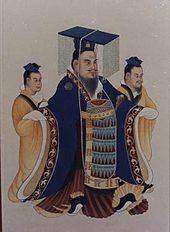Han conquest of Dian
| Han campaigns against Dian | |||||||
|---|---|---|---|---|---|---|---|
| Part of the southward expansion of the Han dynasty | |||||||
| |||||||
| Belligerents | |||||||
| Han dynasty | Dian | ||||||
The Han campaigns against Dian were a series of Han dynasty military campaigns and expeditions recorded in Han Chinese textual sources that were supposed to have occurred against the kingdom of Dian in Yunnan. Dian was placed under Han rule in 109 BC, after Emperor Wudi dispatched an army against the kingdom as the empire expanded southward.
Background
Dian was a tribal kingdom in southwestern China. Han Chinese textual sources[which?] record the claim that it was established by Zhuang Qiao, a Chinese officer serving in an army under the king of Chu during the Warring States period. He had been sent to area as part of failed Chu military campaign. The Qin was overthrown by the Han, and the commanderies of the new dynasty, Ba and Shu, bordered Dian.[1]
Campaigns

The earliest Han expedition against Dian was led by Tang Meng in 135 BC, who established the Jianwei commandery in the region. The Han had been attracted to the wealth of the kingdom, which traded cattle, fruit, horses, and slaves. Han soldiers opened up new trade routes, then expanded further north, toward an area near Shu.[2] The commandery was later abandoned because of rising costs and the wars against the Xiongnu to the north of China.[3] A later Chinese expedition, heading south to established a trade route after a report on Central Asian trade in 122 BC, was captured by the Dian for four years.[3]
A military campaign dispatched by Emperor Wudi in 109 BC invaded and annexed Dian.[4] The Yizhou commandery was established in the former kingdom.[2] Dian's surrender was verified by archaeologists, who discovered an imperial seal inscribed by the Han for the king of Dian.[3] There were a series of unsuccessful rebellions by the Dian against Han rule.[4] The first two incidents occurred in 86 BC and 83 BC. A rebellion in 35BC–28 BC was suppressed by Chen Li, governor of the Zangge commandery. More violence surfaced during Wang Mang's usurpation of the Han emperor and reign in 9–23. Wang responded by dispatching military campaigns against the southwest. One campaign lost 70% of its soldiers due to illness. Another, with 100,000 men and double the supplies, had little success.[5]
There was also a rebellion in 42–45 and 176. During Emperor Mingdi's reign in 57–75, the Han expanded further, and established a new commandery in Yunnan, Yongchang, west of the former Dian kingdom in Yizhou. In 114, tribes residing west of the Yuesui commandery accepted Han rule.[6] Emperor Huangti embarked on a sinicization campaign during his reign between 146 and 168 that introduced Chinese ethics and culture to the tribes.[5] The continued to be periodic rebellions, follow by their suppression by the Han, [6] but the Dian region remained a part of the Han empire.[4]
Historical significance
The sinicization of the Dian began after the Han annexation of 109 BC and is apparent in the artifacts uncovered by archaeologists in the area.[7] Mirrors, coins, ceramics, and bronzes manufactured in Han style have been found in Yunnan.[8] Emperor Huangti encouraged the teaching of Chinese belief systems in Dian.[5] Dian artifacts, once visually distinct from the Han, borrowed heavily from Han imports by 100 BC, indicative of Dian's decline as a separate culture.[9]
Citations
Bibliography
- Ebrey, Patricia Buckley (2010). The Cambridge Illustrated History of China. Cambridge University Press. ISBN 978-0-521-12433-1.
{{cite book}}: Invalid|ref=harv(help) - Xu, Pingfang (2005). The Formation of Chinese Civilization: An Archaeological Perspective. Yale University Press. ISBN 978-0-300-09382-7.
{{cite book}}: Invalid|ref=harv(help) - Watson, William (2000). The Arts of China to Ad 900. Yale University Press. ISBN 978-0-300-08284-5.
{{cite book}}: Invalid|ref=harv(help) - Yu, Yingshi (1986). Denis Twitchett; Michael Loewe (eds.). Cambridge History of China: Volume I: the Ch'in and Han Empires, 221 B.C. – A.D. 220. University of Cambridge Press. ISBN 978-0-5212-4327-8.
{{cite book}}: Invalid|ref=harv(help)
